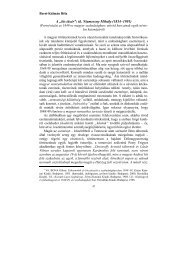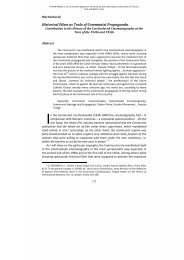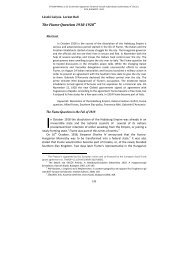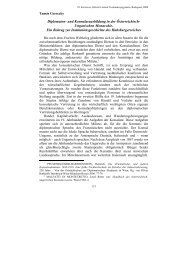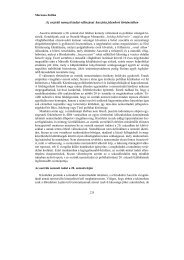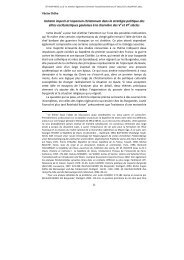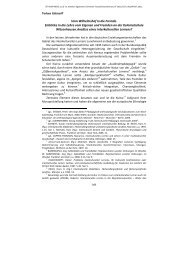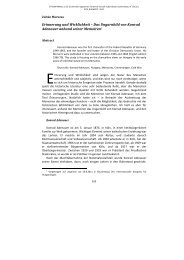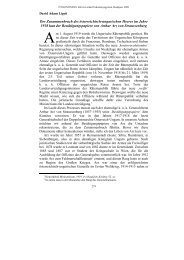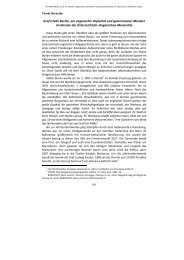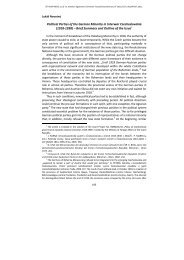The Molotov-Ribbentrop Pact - ELTE BTK Történelem Szakos Portál
The Molotov-Ribbentrop Pact - ELTE BTK Történelem Szakos Portál
The Molotov-Ribbentrop Pact - ELTE BTK Történelem Szakos Portál
Create successful ePaper yourself
Turn your PDF publications into a flip-book with our unique Google optimized e-Paper software.
German Reactions<br />
A last point that must not be underestimated is the output the Germans took<br />
from these incidents. On the one hand they started a large propaganda-campaign in<br />
which the Soviets were depicted as murderers, on the other hand they could easily<br />
gain the local people‘s support in persecuting Jews from the start on. When the<br />
German units took over control they had to rely on the population‘s help because,<br />
as Martin Dean noticed, they would not have been able to identify Jews on their<br />
own. 56 <strong>The</strong> Germans did not put an end to the riots but let them go on or even<br />
motivated them. 57 Initially the Wehrmacht had been ordered to shoot political<br />
commissioners and the Einsatzgruppen had to persecute Soviet political personnel<br />
and especially Jewish cadres. After they discovered the NKVD‘s victims, the range<br />
of victims grew and it was no longer only certain groups within the Jewish<br />
population but the Jews as a group of their own. 58<br />
<strong>The</strong> German propaganda used the NKVD‘s crimes to justify their own crimes.<br />
but after the first wave of violence slowed down, they restricted further riots because<br />
they feared to otherwise lose control. 59 It was now solely the Einsatzgruppen‘s duty<br />
to persecute the Jewish population, even though they had help of local volunteers.<br />
<strong>The</strong> further atrocities against the Jews were carried out according to plans and can<br />
not be compared to the initial spontaneity of actions. 60<br />
Final statements<br />
As the controversy of Bogdan Musial‘s theses shows, it is still not easy to<br />
discuss violence against Jews during the Second World War. <strong>The</strong> Holocaust‘s<br />
shadow often prevents a view on the local population‘s part in the persecution of<br />
their Jewish neighbours. One must not compare one phenomenon with another,<br />
but rather regard the Ukrainian and White Russian‘s pogroms as something that<br />
happened independent from the later German crimes against the Jews. - And by<br />
independent I do not mean on their own initiative, as stated above, but without<br />
initial connection to the later events, as they could not be foreseen.<br />
56<br />
DEAN, Martin: <strong>The</strong> ‚Local Police‘ in Nazi-occupied Belarus and Ukraine as the ‚Ideal<br />
Type‘ of Collaboration - in Practice, in the Recollection of its Members and in the Verdicts of the<br />
Courts. In: TAUBER, Joachim (Ed.): ‚Kollaboration‘ in Nordosteuropa - Erscheinungsformen<br />
und Deutungen im 20. Jahrhundert. Wiesbaden, 2006. 418.<br />
57<br />
POHL, Dieter: Nationalsozialistische Judenverfolgung in Ostgalizien 1941-1944 -<br />
Organisation und Durchführung eines staatlichen Massenverbrechens. München, 1996. 59.<br />
58<br />
Ibidem. 138.<br />
59<br />
Ibidem. 66. HILBERG, Raul: Täter, Opfer, Zuschauer - Die Vernichtung der Juden 1933-<br />
1945, Frankfurt am Main, 1992. 198.<br />
60<br />
OVERY, Richard: Russlands Krieg - 1941-1945, Reinbek bei Hamburg, 2003. 221.<br />
POHL, Dieter: Ukrainische Hilfskräfte beim Mord an den Juden. In: PAUL, Gerhard (Ed.):<br />
Die Täter der Shoah - Fanatische Nationalsozialisten oder ganz normale Deutsche?,<br />
Göttingen, 2002. 212-219, 224.<br />
180



